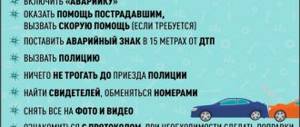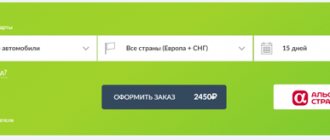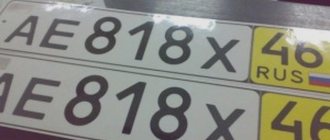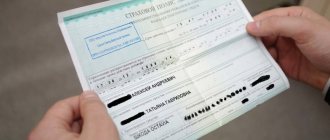List of documents
The number of documents that a driver constantly needs to carry with him is not that large. The list includes:
- Driver's license (valid).
- OSAGO/CASCO insurance policy, which after purchasing a car can only be obtained if you have a driver’s license, a registration certificate of the previous owner and a purchase and sale agreement. You can apply for a policy at any branch of the insurance company of the car owner’s choice. It is worth taking into account the fact that when applying for a policy outside your place of permanent residence, there may be no service in your city under the policy if there is no branch of the insurance company.
- A certificate of registration of a vehicle in the MREO of the State Traffic Safety Inspectorate can be obtained if you have a title, a document confirming the fact of ownership of the car, a policy and a driver’s license.
There are also some documents that you need to have with you in certain situations:
- If there is a trailer, the driver must have a registration certificate and an insurance policy for it. An endorsement on the driver's license indicating that the driver can drive with a trailer is also required.
- If the owner is engaged in the transportation of passengers on a commercial basis, then he also needs to carry a permit to carry out this activity in the vehicle. The same story applies to trucks with dangerous or large cargo, but in this case, in addition to the above documents, there must also be invoices for the cargo.
Duty
The driver must always have these documents with him. If he is not the owner of the car, then there must be either a power of attorney, or he must be included in the policy. An alternative is a policy “without restrictions”, but all other documents, i.e. certificate and license are still needed.
The driver is not obliged to carry the remaining documents with him and show them during a simple check either to the traffic police inspector or to representatives of other law enforcement agencies.
He may not even hand over the documents to the latter, but show them himself. Therefore, if the requirement for a technical inspection coupon (since without MOT you cannot get insurance, which, by the way, includes technical inspection data), a passport, PTS or other documents is not justified by any factors, then no one has the right to force them to be presented.
Other features of the document presentation process
The main rule to consider when meeting with law enforcement officials is politeness. Even if the driver films his communication with them on camera or records it on a voice recorder (which is sometimes necessary), you need to warn about this. There is no need to be rude in response to a careless traffic police officer, but filming or recording in such a situation is mandatory in order to further prove that you are right if problems arise.
If the traffic police inspector requires other documents, then the driver should not argue with him; he can calmly answer that they are not required by law. If, in the event of a conflict initiated by either party, a traffic police officer took into his car the documents presented to him by the driver and does not want to give them back, you need to call the police on 02, report where and which employees are breaking the law, then calmly wait for the situation to be resolved.
Documents and money for the trip
Exactly needed:
Passport: internal or foreign When traveling around Russia, take an internal passport. Abroad, a passport is sufficient. An internal passport will come in handy if your foreign passport is stolen, but even then you can do without it. Bank card If you are traveling abroad, notify your bank that you plan to use the card outside of Russia. Typically, employees ask for a specific country and travel dates, as well as to set a daily cash withdrawal limit. Also keep in mind that at check-in some airlines ask you to show the card with which you paid for air tickets. Documents for the child: 1) passport, 2) birth certificate, 3) consent to leave Russia if the child is traveling abroad without parents. If children crossing the border with one of the parents, permission to leave is not required. Cash When going abroad, take cash in dollars or euros: unlike rubles, they will be exchanged for local currency everywhere. If you are flying to a country with a paid visa on arrival, take the money for the visa without change.May be useful:
Airplane, train, bus tickets You usually don’t need to print out your tickets: most airlines will check you in using your passport only; in other cases, a copy on your smartphone will suffice. But sometimes a printout is still required. Check with the carrier or just take it with you just in case. Hotel reservations Most hotels will accommodate you without a “paper” reservation: just show it on the smartphone screen or give your last name. But if you feel safer, print it out. Driving license If you are going to drive a car abroad, check whether the country you want has joined the Vienna Convention. If yes, then you can drive there with a national driver’s license, including Russian. If your country is a member of the Geneva Convention, take two driving licenses: national and international. It is convenient to look at the list of countries under both conventions on Wikipedia. Copy of passport Just in case, print out a couple of copies of the main page of your passport. And also send the scans to yourself by email. Traveler's insurance policy Read how to choose good medical travel insurance and what to insure besides health.Take essential things - documents, chargers, gadgets - in your hand luggage. Then, if your luggage is delayed or lost, you will not be left with nothing.
Complete list of required driver documents
What documents must the seller provide before the purchase and sale transaction?
When transporting a group of children in an organized manner, the bus driver must have the following documents with him:
1) a driver’s license for the right to drive a vehicle of the appropriate category;
2) registration documents for this vehicle;
3) waybill;
4) an insurance policy for compulsory civil liability insurance of the vehicle owner;
5) copies of the following documents:
— traffic schedule and route diagrams approved by the head or official responsible for ensuring road safety, organization, or an authorized person of the charterer;
- a document containing the procedure for boarding children on the bus, established by the head or official responsible for ensuring road safety, an educational organization, an organization providing training, an organization carrying out educational activities, a medical organization or other organization, an individual entrepreneur carrying out organized transportation of a group children by bus (hereinafter referred to as the organization), or by the charterer, except for the case when the specified procedure for boarding children is contained in the charter agreement;
— decisions on assigning escort of buses by a vehicle (vehicles) of a unit of the State Traffic Inspectorate or notification of a negative decision based on the results of consideration of an application for such escort;
- a document containing information about the medical worker (last name, first name, patronymic, position), a copy of the license to carry out medical activities or a copy of the agreement with a medical organization or individual entrepreneur who has the appropriate license - in case of organized transportation of a group of children in intercity traffic by an organized transport convoy for more than 3 hours according to the traffic schedule;
Note. In information about a medical worker, it is advisable to indicate his contact phone number.
- a list of a set of food products (dry rations, bottled water) according to the assortment established by the Federal Service for Surveillance on Consumer Rights Protection and Human Welfare or its territorial administration - if children are on the route according to the traffic schedule for more than 3 hours;
- a list of appointed accompanying persons (indicating the last name, first name, patronymic of each accompanying person, his telephone number), a list of children (indicating the last name, first name, patronymic and age of each child) for the bus he drives, information about the numbering of buses when moving (when carrying out transportation by 2 or more buses).
Note. The number of accompanying persons per 1 bus is assigned based on their presence at each door of the bus, while one of the accompanying persons is responsible for the organized transportation of a group of children on the corresponding bus and coordinates the actions of the driver (drivers) and other accompanying persons on the specified bus.
If 2 or more buses are used to carry out the organized transportation of a group of children, the head or official responsible for ensuring road safety of the organization, and in the case of organized transportation of a group of children under a charter agreement, the charterer appoints a senior person responsible for the organized transportation of a group of children and coordination actions of drivers and those responsible for buses carrying out such transportation.
Pre-trip and post-trip medical examination marks
Signs on the dashboard that every driver should know. There is an exclamation mark on the speedometer
Each institution that operates vehicles is required to conduct pre-trip and post-trip medical examinations of drivers. This responsibility is assigned to them in accordance with paragraph 1 of Article 20 and Article 23 of the Federal Law of December 10, 1995 No. 196-FZ “On Road Safety”. Let us note that the Ministry of Health of Russia, together with the Ministry of Transport of Russia, approved the Methodological Recommendations “On the organization of pre-trip medical examinations of vehicle drivers” (see letter of the Ministry of Health of Russia dated August 21, 2003 No. 2510/9468-03-32). This document regulates the procedure for conducting medical examinations of drivers and, first of all, should help the institution to properly organize this process.
A stamp is placed on the waybill indicating the date and exact time of the medical examination, the surname, initials and signature of the medical worker who conducted the examination. The stamp is placed only if there are no symptoms of the disease, the driver is drunk, etc.
Pre-trip medical examinations can only be carried out by personnel who have the appropriate certificate, as well as medical institutions with a license. This position is also confirmed by judicial practice (resolution of the Federal Antimonopoly Service of the Ural District dated August 1, 2005 No. F09-3196/05-S7).
Let us remind you that the absence of a stamp confirming the completion of a pre-trip inspection may be qualified as a violation of the law.
When is it necessary to fill out a waybill?
What documents are needed to obtain a TIN?
Let's consider article 6 of the federal law “Charter of road transport and urban ground electric transport”:
Article 6. Waybills 1. Mandatory details and the procedure for filling out waybills are approved by the federal executive body exercising the functions of developing state policy and legal regulation in the field of transport, in the manner established by the Government of the Russian Federation.
2. It is prohibited to transport passengers and luggage, cargo by buses, trams, trolleybuses, cars, trucks without issuing a waybill for the corresponding vehicle.
Pay attention to the second paragraph of the article. It lists situations in which driving vehicles is prohibited (transportation of passengers and luggage, cargo)
Let's consider the concepts passenger, baggage and cargo:
1) luggage - the passenger’s belongings accepted for transportation in the prescribed manner;
3) cargo - a material object accepted for transportation in the prescribed manner;
12) passenger - an individual who has entered into an agreement for the carriage of a passenger, or an individual for the purpose of whose transportation a vehicle charter agreement has been concluded;
Diagnostics without paper
This is wrong. No one has obligated drivers to carry this document with them since the beginning of the year. A complete list of documents that the driver must have is listed in paragraph 2.1.1 of the Traffic Rules. It changed on January 2nd. But only to the extent that drivers who have purchased an electronic MTPL policy are allowed to present it in the form of an electronic document. That is, on a smartphone or tablet. Nobody added a diagnostic card to this list of documents.
Moreover, the diagnostic card itself in the form of a paper document will soon simply not exist. On June 8, amendments to the law on technical inspection come into force, according to which the diagnostic card will be issued directly in the automated information system UAIS TO. In hand, and only at the request of the car owner, a copy of it on paper will be issued.
The Code of Administrative Offenses does not provide for liability for the lack of a diagnostic card in the hands of the driver.
But on July 27, amendments to the Code of Administrative Offenses come into force, which provide for liability for “driving a vehicle for which a diagnostic card has not been issued in the prescribed manner.” In other words, they will be punished for the fact that the UAIS MOT does not have a diagnostic card for this particular car.
Moreover, this violation will be detected using automatic recording cameras. At the same time, the Code of Administrative Offenses clearly states that such a violator can be punished only once a day. That is, if one day he drives under a dozen cameras without a technical inspection, he will receive one fine. But - serious. Two thousand rubles. Let us remind you that for the absence of an MTPL policy we have a fine of 800 rubles.
If you drive a car without a technical inspection under a dozen cameras a day, you will receive one fine
Let us remind you that if the car is not three years old, then it does not need a diagnostic card. From 3 to 7 years of age, inspection must be done every two years. And for cars older than 7 - every year. Buses and taxis must undergo maintenance once every six months.
Without a valid diagnostic card, it is impossible to purchase an MTPL policy. And without it you cannot drive a car. But cunning car owners here have also adapted to undergo technical inspection on old cars every two years. They buy insurance while the old diagnostic card is still valid. For example, when there are 10 days left before the end of the year. And the next year they drive with an MTPL policy, but without a technical inspection.
When the penalty for the lack of a diagnostic card in the UAIS TO comes into effect, this practice will become a thing of the past.
Let us remind you that the amendments to the law on technical inspection also include mandatory photographing of the car during technical inspection and placement of these photographs in the UAIS TO indicating the coordinates of the shooting location. It is expected that this will make it possible to cover up the practice of trading diagnostic cards, when motorists purchased them without even coming to the inspection point. But there are suspicions that there will be ways to get around this obstacle.
Paid parking in the capital was introduced on another 80 streets:
What documents should the driver carry with him in the car?
Over time, brake fluid loses its properties and this is primarily due to the fact that brake fluid is hygroscopic. Because of this, during operation the percentage of water in the fluid increases, which under heavy loads leads to excessive gas release, which can result in brake failure. The water content in brake fluid can be determined using a special measuring device. If you have not changed the brake fluid on your car for a long time, even if the car has not been used for a long time, we strongly recommend that you do so. It is also necessary to monitor the brake fluid level in the brake system - a low fluid level indicates a possible leak in the brake system or an excessively high level of brake pad wear. It is advisable that repairs to the brake system be carried out by service station specialists.
10. Coolant. The coolant level and its condition are one of the indicators of engine health. Check the coolant level only when the engine is cold! There are always marks on the expansion tank indicating this. Since water expands when heated, liquid level indicators will be unreliable and as a result there may not be enough liquid to ensure normal engine operation. If possible, inspect the radiator, hoses, and clamp connections. If you find drops or white residue from evaporation, this is a clear sign that there is damage in this area and coolant may be leaking here. Detecting a leak in a timely manner and eliminating it will save you from unnecessary, more serious engine repairs. After checking the coolant level, do not forget to check its quality
The main thing you need to pay attention to is that the presence of oil components in the coolant indicates possible malfunctions in the engine cooling system
If during the diagnostic process you notice any deviations from our recommendations, or are simply not entirely confident in your conclusions, we recommend that you contact a good car service center to obtain qualified diagnostic data and further troubleshooting. It is better to identify any breakdown at home rather than try to fix it on the road on your own!
The question of what documents you need to carry with you in the car arises for many car enthusiasts. You can, of course, store the entire set in the glove compartment, but the risk of losing them is too great, and you will have to spend a lot of time and money to restore them. Therefore, keep only the documents required for verification with you. And we will tell you what these include below.
Documents for the car
The main problem is that domestic legislation is too inconsistent. New laws, as well as changes and additions to old ones, appear so often that even experienced drivers may find themselves in a situation where they may need the help of a professional lawyer. Therefore, it is so important to keep track of any information regarding what documents the driver needs to have with him in order to present them to the inspector. Of course, communication with a representative of the law in such cases should not be conducted in a raised tone, and if he demands to present documents, the driver has the right to show them in expanded form, without handing them directly into his hands (if this is not a traffic police inspector). Now let’s talk about which documents you need to take with you, and which ones you should keep under seven locks at home. A maintenance certificate and a power of attorney are anachronisms that are currently not required to be presented.
Essentially, the car must have:
- vehicle registration certificate;
- PTS (however, there are disagreements in the interpretation of legal norms relating to this document);
- OSAGO policy;
- VU.
The absence of any of the listed documents (except PTS) may lead to the application of penalties (since 2013 this is 500 rubles). Let's look at all these documents separately.
Vehicle registration certificate
According to current legislation, the CP is the main document indicating that you are the legal owner of this vehicle. In fact, the registration certificate indicates that after purchasing the car, you carried out the procedure for registering it, receiving the appropriate paper in your hands. The certificate indicates almost all the details of your car: make/model, year of manufacture, identification parameters (chassis/body numbers and VIN code), information about the driver, including his place of permanent residence/registration. Note that, according to the latest changes in the legislative framework, the number of the power unit is not indicated in the SR. Please note that the driver must carry this document with him at all times. Since it is a laminated plastic card of standard sizes, it will not take up much space in the car.
PTS
Many drivers, especially beginners, do not understand the difference between a registration certificate and a vehicle passport, although these are completely different documents. Another problem is that the wording in the law about the need to carry a vehicle with you is still considered quite controversial. Those drivers who consider themselves legally savvy may well refuse to present a vehicle passport with proper reasoning. Indeed, in essence, a PTS is a document confirming the fact that a particular vehicle is in full technical condition and has permission to travel on public highways. It partially duplicates the information present in the registration certificate, and also provides extended data on the technical characteristics of the car.
From the point of view of the law, the PTS is important (or rather, irreplaceable) when performing any operations with a vehicle related to a change in its owner (sale, act of donation) and when registering. But the law does not require mandatory presence in the car, since, as already noted, the inspector can find out all the information about the driver and the car from the registration certificate. In other words, the list of documents that the driver is required to provide to the traffic police inspector does not include the vehicle passport. However, there are situations when presentation of PTS is necessary:
- when the car passes through customs control. In this case, the presence of this document will be proof of the legality of crossing the border of the Russian Federation;
- in the event of a vehicle theft, the PTS will be considered proof that you are the owner of the car;
- If an accident occurs, the vehicle's passport will need to be provided to a representative of the insurance company.
And if the probability of the first two cases is negligible or can be calculated, then the risk of getting into an emergency situation cannot be calculated. This means that you yourself will have to decide whether to take the vehicle with you or leave it at home. Remember also that the vehicle passport is the basis for restoring other documents for the car in the event of their theft/loss. It is this fact that testifies in favor of the fact that it is better to store PTS at home.
OSAGO policy
For a long time, car insurance was a purely voluntary matter, and among the documents required for any vehicle was a state inspection ticket. Recently, technical inspections have been carried out without issuing a ticket that is stuck on the windshield. At the same time, each driver is obliged to purchase a compulsory motor liability insurance policy, which provides compensation for damage by the insurer to the damaged car. It is impossible to obtain a policy without presenting a diagnostic card, which replaced the above-mentioned coupon. Such a diagnostic card is issued by certified centers authorized to carry out instrumental diagnostics of the technical condition of vehicles, indicating that the vehicle is allowed to participate in road traffic.
Since the MTPL policy is not issued without the presence of a recreation certificate, you do not need to carry the latter with you. But the driver must present his insurance to the patrol officer. Of course, the MTPL policy is presented not only to convince the traffic cop that your car is in good working order. Its presence indicates that this car is insured according to the state driver insurance program for motor third-party liability. In the absence of a policy, the traffic police inspector has the right to apply administrative sanctions to the offending driver, the severity of which depends on whether the driver forgot the document at home or does not have insurance at all.
It is worth mentioning one nuance regarding insurance policies: there is an opinion that CASCO insurance has the same powers as compulsory motor liability insurance. In fact, this is an obvious misconception: the CASCO policy is by no means proof that the car has passed inspection and has a diagnostic card. You don't need to take it with you. O covers damage caused not to the policy owner, but to another injured participant in the accident. CASCO insurance insures the owner’s car. Of course, these policies partially overlap each other's capabilities, but they are not interchangeable, and only compulsory motor liability insurance has the status of mandatory. That is, by insuring a car under the CASCO program, you do not get rid of the requirement to purchase MTPL insurance.
Documents confirming the ownership of the vehicle
In principle, this function is performed by a vehicle passport, but sometimes it may be necessary to present other papers indicating the legality of ownership of the car and the rights to fully use it. Such documents may be:
- customs declaration (if the car was imported from abroad);
- purchase and sale agreement (when purchasing a car on the secondary market).
If a vehicle is purchased through an official dealer, customs clearance responsibilities fall on the shoulders of the seller at the time the car is imported into our country. We remind you that the driver is not required to provide these documents to the traffic police officer; they will only be required if the car is sold or for travel abroad. So you need to take them into the car only in specific cases.
Do I need a waybill for a passenger car?
Let's immediately highlight the drivers who do not need a waybill:
1. If the car belongs to an individual and is used by him for his own purposes or is transferred to another individual by proxy.
2. If the car belongs to a legal entity and accounting for fuel costs does not matter for this legal entity.
This situation is not fictitious; let’s look at it with an example. Let the car belong to an individual entrepreneur who uses the simplified taxation system and has chosen income as the taxable base. In simple terms, only the income of this legal entity is subject to taxes, regardless of its expenses. In the described example, it doesn’t make much sense to process waybills, because










